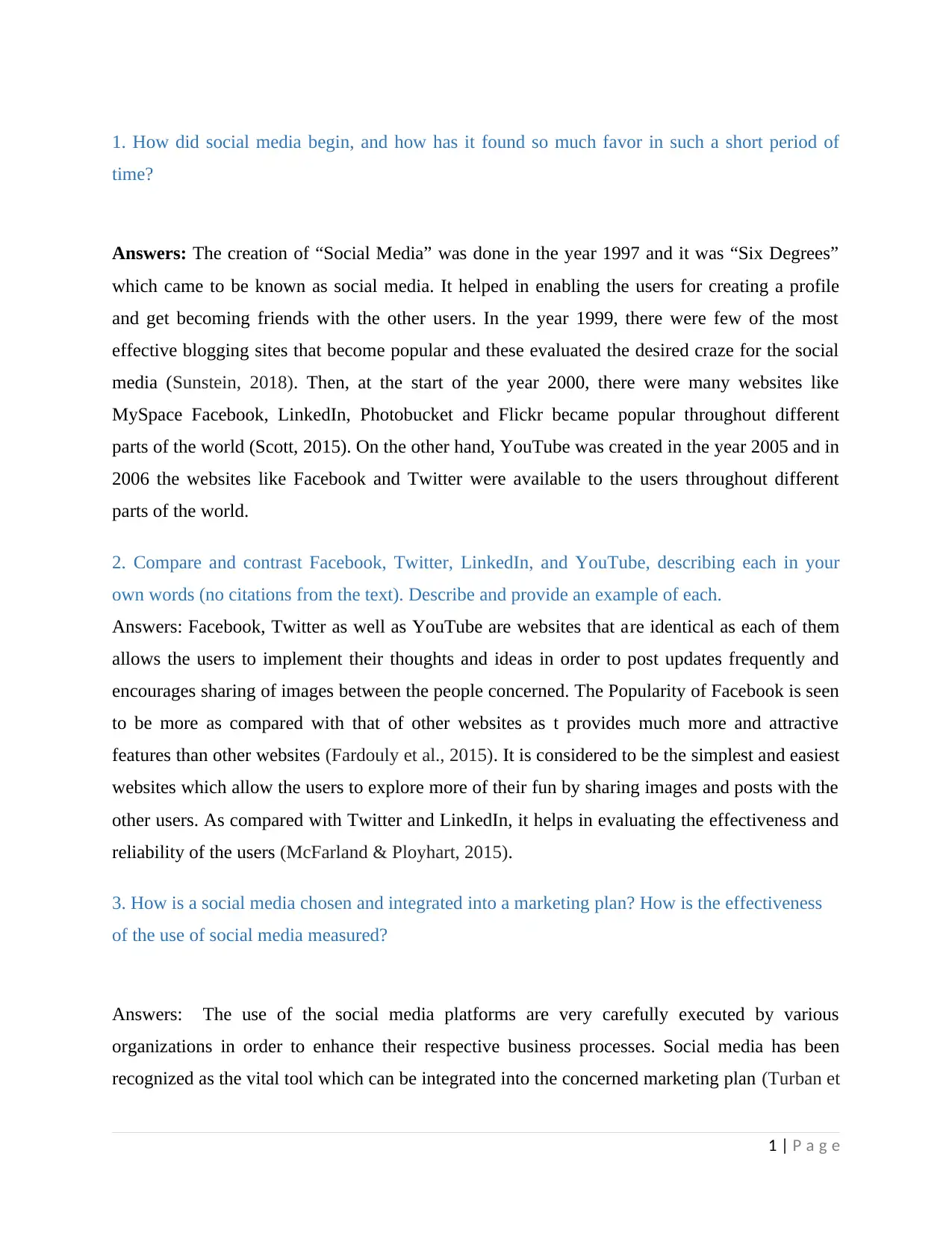Principles of Marketing: Social Media Strategies and Christian Values
VerifiedAdded on 2021/06/15
|4
|1027
|32
Homework Assignment
AI Summary
This assignment delves into the principles of social media marketing, starting with the historical emergence and rapid adoption of social media platforms. It compares and contrasts Facebook, Twitter, LinkedIn, and YouTube, highlighting their unique features and marketing applications. The assignment further discusses how social media is integrated into marketing plans, emphasizing the importance of metrics like volume, reach, and engagement for measuring effectiveness. Finally, it addresses the ethical responsibilities of Christians in business, stressing the importance of integrity and good intent when serving others. This comprehensive overview provides a solid understanding of social media marketing principles and ethical considerations.

Principles of Marketing Business
0 | P a g e
0 | P a g e
Paraphrase This Document
Need a fresh take? Get an instant paraphrase of this document with our AI Paraphraser

1. How did social media begin, and how has it found so much favor in such a short period of
time?
Answers: The creation of “Social Media” was done in the year 1997 and it was “Six Degrees”
which came to be known as social media. It helped in enabling the users for creating a profile
and get becoming friends with the other users. In the year 1999, there were few of the most
effective blogging sites that become popular and these evaluated the desired craze for the social
media (Sunstein, 2018). Then, at the start of the year 2000, there were many websites like
MySpace Facebook, LinkedIn, Photobucket and Flickr became popular throughout different
parts of the world (Scott, 2015). On the other hand, YouTube was created in the year 2005 and in
2006 the websites like Facebook and Twitter were available to the users throughout different
parts of the world.
2. Compare and contrast Facebook, Twitter, LinkedIn, and YouTube, describing each in your
own words (no citations from the text). Describe and provide an example of each.
Answers: Facebook, Twitter as well as YouTube are websites that are identical as each of them
allows the users to implement their thoughts and ideas in order to post updates frequently and
encourages sharing of images between the people concerned. The Popularity of Facebook is seen
to be more as compared with that of other websites as t provides much more and attractive
features than other websites (Fardouly et al., 2015). It is considered to be the simplest and easiest
websites which allow the users to explore more of their fun by sharing images and posts with the
other users. As compared with Twitter and LinkedIn, it helps in evaluating the effectiveness and
reliability of the users (McFarland & Ployhart, 2015).
3. How is a social media chosen and integrated into a marketing plan? How is the effectiveness
of the use of social media measured?
Answers: The use of the social media platforms are very carefully executed by various
organizations in order to enhance their respective business processes. Social media has been
recognized as the vital tool which can be integrated into the concerned marketing plan (Turban et
1 | P a g e
time?
Answers: The creation of “Social Media” was done in the year 1997 and it was “Six Degrees”
which came to be known as social media. It helped in enabling the users for creating a profile
and get becoming friends with the other users. In the year 1999, there were few of the most
effective blogging sites that become popular and these evaluated the desired craze for the social
media (Sunstein, 2018). Then, at the start of the year 2000, there were many websites like
MySpace Facebook, LinkedIn, Photobucket and Flickr became popular throughout different
parts of the world (Scott, 2015). On the other hand, YouTube was created in the year 2005 and in
2006 the websites like Facebook and Twitter were available to the users throughout different
parts of the world.
2. Compare and contrast Facebook, Twitter, LinkedIn, and YouTube, describing each in your
own words (no citations from the text). Describe and provide an example of each.
Answers: Facebook, Twitter as well as YouTube are websites that are identical as each of them
allows the users to implement their thoughts and ideas in order to post updates frequently and
encourages sharing of images between the people concerned. The Popularity of Facebook is seen
to be more as compared with that of other websites as t provides much more and attractive
features than other websites (Fardouly et al., 2015). It is considered to be the simplest and easiest
websites which allow the users to explore more of their fun by sharing images and posts with the
other users. As compared with Twitter and LinkedIn, it helps in evaluating the effectiveness and
reliability of the users (McFarland & Ployhart, 2015).
3. How is a social media chosen and integrated into a marketing plan? How is the effectiveness
of the use of social media measured?
Answers: The use of the social media platforms are very carefully executed by various
organizations in order to enhance their respective business processes. Social media has been
recognized as the vital tool which can be integrated into the concerned marketing plan (Turban et
1 | P a g e

al, 2017). As for example, while developing the use of social media it provides the opportunities
to integrate the minor elements of the social media within the marketing plan of the firm. On the
other hand, the idea of socializing of the marketing plan is the effective way for reaching the
desired audience throughout the concerned market areas.
There should use the metrics like volume, reach, exposures as well as implications by engaging
the customers with the execution and evaluation of the business processes. The replies received
by the participants will help in evaluating the desired growth of the firm and will help to measure
the effectiveness of the organization. The social media elements should be integrated with the
existing marketing plan of the firm and it then will be helpful in promoting the growth of the
organization (Tuten & Solomon, 2017).
4. “I know, my God, that you examine our hearts and rejoice when you find integrity there.” (1
Chron. 29:17 NLT) Explain our responsibility as Christians to be wholesome, truthful, and with
good intent when serving the needs of others in personal or business matters.
Answers: The statement particular reminds that GOD knows all and every aspect of the human
mind and heart. He effectively examines them very closely and searches for the desired integrity.
Moreover, it is important to understand the actual meaning of integrity and is defined as the
acting the same way on both sides of the human body that is internally and externally (Chase,
2018). The Godly convections of the human beings effectively matches the outside actions taken
(Ramsay 2018).
2 | P a g e
to integrate the minor elements of the social media within the marketing plan of the firm. On the
other hand, the idea of socializing of the marketing plan is the effective way for reaching the
desired audience throughout the concerned market areas.
There should use the metrics like volume, reach, exposures as well as implications by engaging
the customers with the execution and evaluation of the business processes. The replies received
by the participants will help in evaluating the desired growth of the firm and will help to measure
the effectiveness of the organization. The social media elements should be integrated with the
existing marketing plan of the firm and it then will be helpful in promoting the growth of the
organization (Tuten & Solomon, 2017).
4. “I know, my God, that you examine our hearts and rejoice when you find integrity there.” (1
Chron. 29:17 NLT) Explain our responsibility as Christians to be wholesome, truthful, and with
good intent when serving the needs of others in personal or business matters.
Answers: The statement particular reminds that GOD knows all and every aspect of the human
mind and heart. He effectively examines them very closely and searches for the desired integrity.
Moreover, it is important to understand the actual meaning of integrity and is defined as the
acting the same way on both sides of the human body that is internally and externally (Chase,
2018). The Godly convections of the human beings effectively matches the outside actions taken
(Ramsay 2018).
2 | P a g e
⊘ This is a preview!⊘
Do you want full access?
Subscribe today to unlock all pages.

Trusted by 1+ million students worldwide

References
Chase, M. (2018). ‘True Democratic Sympathy’: Charles Stubbs, Christian Socialism, and
English Labour, 1863–1912. Labour History Review, 83(1), 1-28.
Fardouly, J., Diedrichs, P. C., Vartanian, L. R., & Halliwell, E. (2015). Social comparisons on
social media: The impact of Facebook on young women's body image concerns and
mood. Body Image, 13, 38-45.
McFarland, L. A., & Ployhart, R. E. (2015). Social media: A contextual framework to guide
research and practice. Journal of Applied Psychology, 100(6), 1653.
Ramsay, L. M. (2018). The Church of England, Homosexual Law Reform, and the Shaping of
the Permissive Society, 1957–1979. Journal of British Studies, 57(1), 108-137.
Scott, D. M. (2015). The new rules of marketing and PR: How to use social media, online video,
mobile applications, blogs, news releases, and viral marketing to reach buyers directly.
John Wiley & Sons.
Sunstein, C. R. (2018). # Republic: Divided democracy in the age of social media. Princeton
University Press.
Turban, E., Outland, J., King, D., Lee, J. K., Liang, T. P., & Turban, D. C. (2017). Electronic
Commerce 2018: A Managerial and Social Networks Perspective. Springer.
Tuten, T. L., & Solomon, M. R. (2017). Social media marketing. Sage.
3 | P a g e
Chase, M. (2018). ‘True Democratic Sympathy’: Charles Stubbs, Christian Socialism, and
English Labour, 1863–1912. Labour History Review, 83(1), 1-28.
Fardouly, J., Diedrichs, P. C., Vartanian, L. R., & Halliwell, E. (2015). Social comparisons on
social media: The impact of Facebook on young women's body image concerns and
mood. Body Image, 13, 38-45.
McFarland, L. A., & Ployhart, R. E. (2015). Social media: A contextual framework to guide
research and practice. Journal of Applied Psychology, 100(6), 1653.
Ramsay, L. M. (2018). The Church of England, Homosexual Law Reform, and the Shaping of
the Permissive Society, 1957–1979. Journal of British Studies, 57(1), 108-137.
Scott, D. M. (2015). The new rules of marketing and PR: How to use social media, online video,
mobile applications, blogs, news releases, and viral marketing to reach buyers directly.
John Wiley & Sons.
Sunstein, C. R. (2018). # Republic: Divided democracy in the age of social media. Princeton
University Press.
Turban, E., Outland, J., King, D., Lee, J. K., Liang, T. P., & Turban, D. C. (2017). Electronic
Commerce 2018: A Managerial and Social Networks Perspective. Springer.
Tuten, T. L., & Solomon, M. R. (2017). Social media marketing. Sage.
3 | P a g e
1 out of 4
Related Documents
Your All-in-One AI-Powered Toolkit for Academic Success.
+13062052269
info@desklib.com
Available 24*7 on WhatsApp / Email
![[object Object]](/_next/static/media/star-bottom.7253800d.svg)
Unlock your academic potential
Copyright © 2020–2025 A2Z Services. All Rights Reserved. Developed and managed by ZUCOL.





